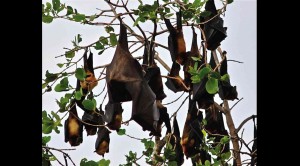Wilderness island up for ecotourism

A COLONY of island flying foxes and large flying foxes roosts in the mangrove forest on Cabgan Island, Tubigon town, Bohol province. Photo courtesy of Tubigon Tourism
TUBIGON, Bohol–As if painted on canvass, the thicket of mangroves emerges in the middle of a seemingly endless expanse of blue water. A speedboat bearing visitors approaches slowly but the movement nevertheless stirs nearly a dozen creatures to fly out in circles from their arboreal haunt.
Upon closer look, one sees not birds for their coat is too shiny and their ears, too big. They are bats—actually, large flying foxes and island flying foxes—that roost on Cabgan, an 85-hectare island in Barangay Macaas, Tubigon town, in Bohol province.
Cabgan is in the Clarin Group of Islands Wilderness Area, a protected seascape. Its mangrove forest and other scenic attractions are being showcased by the municipal government of Tubigon as a community-based ecotourism site. The other Clarin islands are Cancostino, Tabaon, Maagpit and Silo-siloan.
Stewards
Residents will operate the tour to encourage them to become stewards of the island, which is part of Danajon Bank Double Barrier Reef, considered one of only six double-barrier reefs in the world.
Article continues after this advertisementCabgan is only 10 minutes by boat from Macaas, but it remains uninhabited. It is flooded during high tide and does not have enough land for houses to be built on. But it is rich in natural resources that Tubigon officials have recognized as a tourist destination.
Article continues after this advertisementTwenty-four mangrove species and at most five roosting sites for flying foxes are found on the island, according to a wildlife survey conducted by the municipality.
The Philippine duck, which has been classified as vulnerable by the International Union for Conservation of Nature, is also seen there, usually foraging mangroves and freshwater and saltwater habitats for food, such as fish, shrimps and insects.
Other bird species found there are the rufous night heron, black-naped oriole, osprey, whiskered terns, black-winged stilts, little egret, intermediate egret and great egret.
The 7.2-magnitude earthquake that hit Bohol on Oct. 15, 2013, damaged the coral cover of Cabgan, according to Zoological Society of London, but the island still has the potential to attract tourists.
Tour guides
Tubigon Mayor Marlon Amila said the municipality had set aside P1.5 million for its ecotourism project.
Members of Malambuong Turismo sa Macaas Tubigon (Matumatu) would be trained to run the tour, said Boboi Costas of Grassroot Travel who has been tapped as ecotourism consultant. He said the training would involve a range of subjects, from handling tourists to bookkeeping.
In his report about Cabgan, Costas stressed the need to protect the entire island, pointing out that mangroves were being harvested for firewood and fodder to farm animals, while bats were being hunted.
Organized this month,
Matumatu has at least 40 members, mostly the wives of farmers and fishermen and young couples. They have been tapped to become protectors of the environment and for them to earn extra income.
As tour operators and guides, they get 80 percent of the revenue while the remaining 20 percent is remitted to the municipal government as user’s fee, which, in turn, will be used to finance other ecotourism projects. Part of the tour will be a short talk on the importance of bats and mangroves to the environment.
Boardwalks
Costas said an “interpretive center” would be put up on the island where reading materials about bats and mangroves would be available.
A 500-meter boardwalk would be built around the mangrove forest in Barangay Macaas where a river runs through, he said. Another will be put up on Cabgan leading to a viewing deck, about 100 meters from the bats’ roosting sites, to allow tourists to observe the creatures through binoculars and spotting scopes.
Hopefully, both boardwalks would be completed by yearend, Costas said.
Rolelyn Deliña, a tour guide and member of Matumatu, explained that bats have very sensitive hearing such that a slight noise can scare them away.
Aside from bat watching, Cabgan has watercourses and waterways ideal for boating and kayaking.
While there is no tourism facility on the island, bringing in tourists will not be a problem. A boat ride to Tubigon from Cebu takes just one hour. The town is an hour away by land from the capital city of Tagbilaran.
From a small dock in Barangay Macaas, the island is just
10 minutes away by boat.
With community involvement and the island’s natural resources, the addition of Tubigon, particularly Cabgan Island, to Bohol’s tourist attractions is just a matter of time.